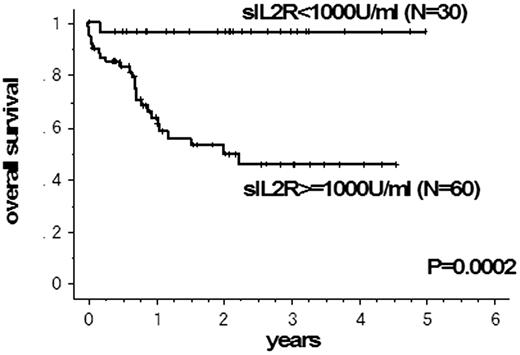Abstract
Abstract 3948
Poster Board III-884
Serum soluble interleukin-2 receptor (sIL2R) is known to be elevated in patients with adult T-cell leukemia, non-Hodgkin lymphoma and Hodgkin lymphoma. Some studies reported the clinical usefulness of pre-treatment sIL2R value as a prognostic factor associated with survival in various NHL. However it has not been adequately examined about the significance of pre-treatment sIL2R value in patients with newly diagnosed diffuse large B-cell lymphoma (DLBCL), especially in rituximab era. We retrospectively analyzed the clinical significance of pre-treatment sIL2R value in 90 patients diagnosed as having DLBCL and treated in our hospital between 2004 and 2008. And we also compared them to patients with follicular lymphoma (FL) and to patinets with lymphadenopathy other than lymphoma. Median age of all 90 patients with DLBCL was 68 years (range, 18 to 88). Thirty-one (34%) patients were less than 60 years. Male/female was 53/37. Thirty-three (37%) patients had stage I or II diseases. Sixty-five (72%) patients were in 0/1 of ECOG performance status (PS). LDH value was elevated above normal range in 55 (61%) patients. Sixteen (18%) patients had 2 or more extranodal diseases. According to International Prognostic Index (IPI), 48 patients and 42 patients were classified as low/low-intermediate risk groups and high-intermediate/high risk groups, respectively. Seventy-nine of 90 patients were treated with R-CHOP or R-CHOP-like chemotherapies with or without radiotherapy. Two-year overall survival rate was 68% in all 90 patients with DLBCL. In all 90 patients with DLBCL, pre-treatment sIL2R value was 4258+/-6850 U/ml (mean+/-SD) which was significantly higher than that in 42 patients with lymphadenopathy other than lymphoma (870+/-892, p<0.0001, t-test). But it was not statistically different between patients with DLBCL and 56 patients with FL (2869+/-3642). In prognostic factor analysis in DLBCL, we examined 6 factors (age, stage, performance status, number of extranodal disease, LDH value and pre-treatment sIL2R value).Univariate analysis showed that stage, LDH, PS and sIL2R were statistically significant factors associated with survival, but age and number of extranodal disease were not. Thirty patients with lower sIL2R (less than 1000U/ml) showed better survival than 60 patients with higher sIL2R (1000U/ml or more). Two-year survival rates were 97% and 53%, respectively (p=0.0002, log-rank test). In these 4 significant factors, multivariate analysis showed sIL2R was the only statistically significant prognostic factor (HR 10.798, 95%CI: 1.320-88.304, p=0.0265). This retrospective analysis suggested that in rituximab era pre-treatment sIL2R value was a useful prognostic factor other than IPI in patients with newly diagnosed DLBCL.
No relevant conflicts of interest to declare.
Author notes
Asterisk with author names denotes non-ASH members.


